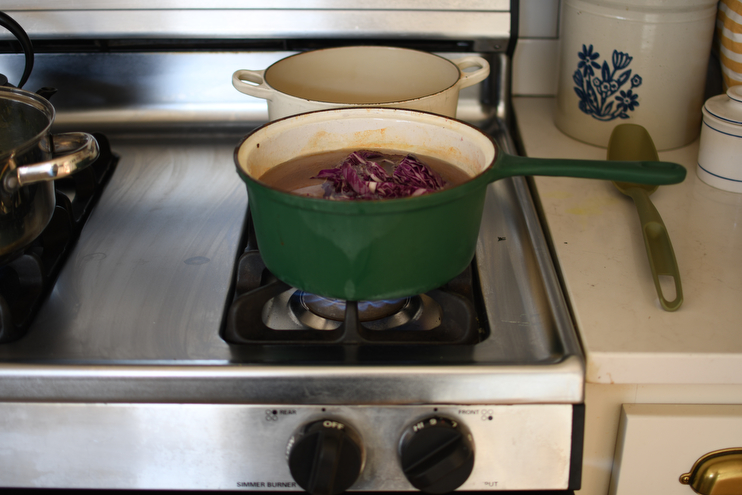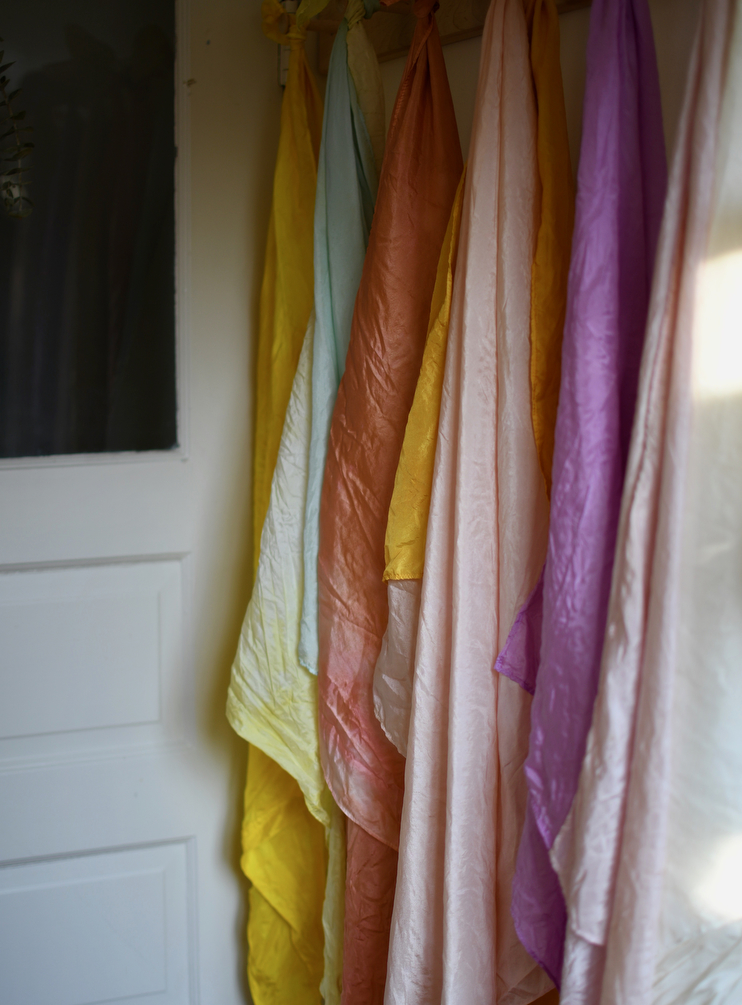









I love working with my hands. It’s one of the ways I fold loving energy into the doings of my day, and it helps me connect with life in a more tangible, intimate way. It also calms me down, helps center my mind, and relieves stress, making me happier! This article has a lot more to say about the beauty of busy hands. There’s a lot to be said for making something, in being a part of a small but wondrous transformation that turns a thing into something else entirely. It’s as close to making magic that I know of, and it illuminates my spirit. And then there’s beauty, for making things more beautiful than they have to be is such a delight and supreme pleasure. Here’s how I made one of my more recent projects: plant dyed play silks. They are one of our favorite open-ended toys here at home, as they are full of imaginative possibilities for little ones. You can use them as capes, crowns, forts, streams, in villages, or anything really, as they are quite fluid and open to many creative paths.
We love play silks, and get most of ours here, but I always wondered what it would be like to dye our own. I love the soft, earthy hues that natural dyes gives nature fibers and fabric, and given that the silks are indeed made of silk, they took very well to these beautiful plant dyes. And what an experiment it was! I learned so much along the way and cannot wait to apply these dyeing methods to various projects from here on out!
Here’s What You’ll Need:
- White Silks – I ordered ours from Dharma Trading Co. and got 12 ( 8mm 35×35)
- Vegetables, spices, and other natural pigments you prefer (see notes below)
- Water
- Large Stockpot
- Distilled White Vinegar
- Baking Soda
- Tongs
- Large Mason Jars
While this process is quite simple, it’s also very varied. By this, I mean that your silks are not going to look like mine. They are going to look like your silks, because there are about a thousand and one ways to get a desired outcome. So be patient with yourself and try and view this project for what it is, a grand experiment that will result in some bright and silky magical play things!
Natural Colors:
- Red Cabbage = Bright purplish pink
- Red Cabbage + Baking Soda = Light bluish green
- Avocado Pits = Blush pink
- Red Beets = light red and pink
- Hibiscus Tea + Beets = coral red
- Kale = light yellow
- Powdered Turmeric = golden yellow
- Red Cabbage + Powdered Turmeric = bright orange
- Dried Black Beans = deep blue
- Chlorophyll = dark green


Steps To Dye:
- Make Your Dye: Add as much plant matter as you want to a large pot of water with a cup of white vinegar. Vinegar will help the dye set. Bring the water to a boil and then reduce the heat, letting the plant matter break down into the water, thereby changing its color. You can do this for 30 minutes, or 3 hours. It’s totally up to you, and just depends on the vibrancy you are looking for. Scoop some water into a glass jar every now and then to see where the color is at, and either let it keep stewing, or decide it’s done if it looks right to you.
- Strain: Once your dye looks good, strain the plant matter from the water and pour the dye into a large mason jar. This liquid will be hot, so be careful, then compost the leftover plants!
- Dye The Silk: Add one (or two) white play silks to each jar, and let them sit for at least an hour to absorb the dye. You can move them around with a spoon, keep them in there overnight, and even do multiple dunks in different dyes to get a range of colors. It’s totally up to you. Again, this process is one you can personalize.
- Rinse & Dry: When your silk has reached the desired color you are wanting, take it out of the dye and rinse it in cold water until the water runs completely clear. Hang dry out of the sunshine, as it will fade the color, and give to the kiddos once dried!
I hope you give this a try and report back on how the process went for you! Enjoy dyeing with plants, friends. Be warned: it’s very addicting. xx
.jpg)
Joy - This post is absolutely lovely! I just ordered a few silks and can not wait to try this!
admin - Joy, have so much fun experimenting! x Amanda
Heidi - I love these and cannot wait to get going on this project. Have you tried to wash them? How do they hold up? Thanks for the fun weekend project!
admin - Heidi, I would recommend hand washing in a gentle soap, like Castile. I have washed two and they colors have stayed! But it was a gentle wash and then I hung dry. Hope you give it a try! x Amanda
Sarah - Hi Amanda,
What a fun project! I think I’ll put this on our summer project list. I really love the muted colors of the natural dyes. So pretty.
Looking forward to your book! I’m ready to preorder:)
admin - Sarah, oh love, thank you! Have a beautiful Sunday. xx Amanda
Lindsay - These are beautiful! How much powder do you typically use (turmeric & chlorophyll) and where did you find the chlorophyll powder?
Thank you!
xo
Charis - May I ask what type of silk you selected? Looking for the white silks you mentioned on the darmha trading co website and there are a bunch of different types of silk fabric.
admin - Sure! I ordered the 8mm 35×35 xx Amanda
Nicole Spring Frontierdreams - Calendula and marigolds make a beautiful golden yellow, too. We used them to dye silks for Michaelmas. We also dyed some yarn for me to knit with 🙂
caitlin black - do you know if this would work with lightweight canvasor flour sack type fabric. i want to make dishclothes
Coloma - Beautiful 🌈
Question, could we do it with other materials instead of silks? Could we use this process and ingredients to dye cotton onesies or baby Muslim clothes?
Thanks!!
admin - Coloma, oh fun! Any natural fiber, such as cotton or muslin or linen, should hold up to the dyeing really well. The intensity of the color will change depending on the length of time you dye, along with the type of fabric used, but anything natural should work! xx Amanda
Megan - Finally getting around to trying this! Can you share how the silks from Dharma Trading Co have held up please?
admin - Megan, they have held up incredibly well! And my kids are pretty hard on them too. I just got some more to dye and couldn’t be happier with the results. xx Amanda
Show & Tell | The ings of Early Spring » Homesong - […] | NATURALLY DYED PLAY SILK with some mama friends this […]
Anna - Hi! Finally got along to this dyeing method last night after wanting to for so long after reading your post. My question is, what to do with the leftover dye? Is it only “good” for one use or could one save, reheat and dye again? Also curious if one is to save the dye, is there a shelf life because it is natural?
Johanna - Thank you so much for sharing this information! Do you find that the dye sticks to the pot or the mason jars that are used? Trying to decide if I need to buy materials specifically for dyeing because they’ll get colored or if I can use our regular kitchen resources.
phyllis hollenbeck - hi,
Please send information on your book
Phyllis